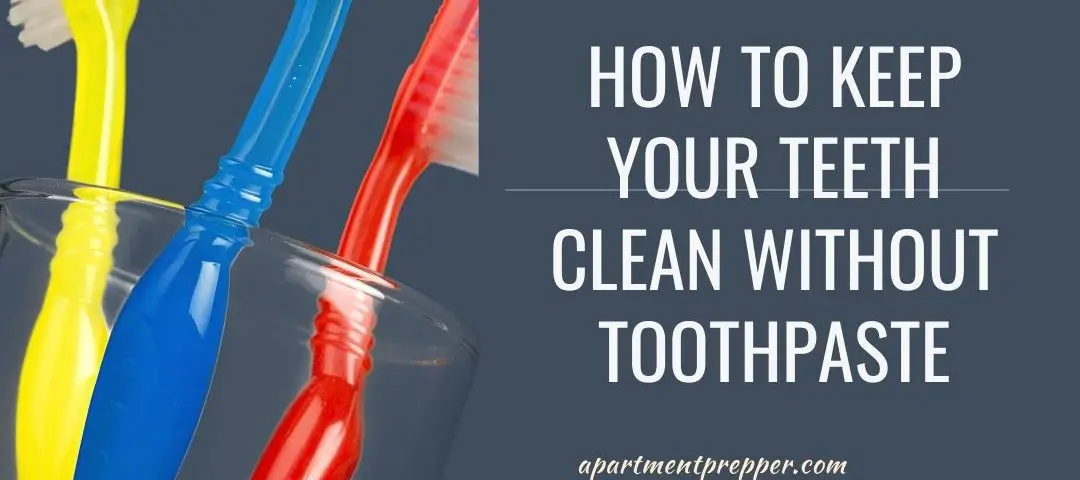This post is by Bernie Carr, apartmentprepper.com
I was watching the third season of the show “Alone” where contestants are dropped off to survive alone in the wilderness. They are only allowed to bring a limited number of personal items. They bring a toothbrush but no toothpaste. So I got to thinking, how do you keep your teeth clean without toothpaste?
There actually are several ways. Let’s look at each of the methods so we can have a backup in case there’s ever a time when we find ourselves with just our toothbrush but no toothpaste.
Before we get into the alternatives, let’s first take a look at what’s in toothpaste.
What’s in your toothpaste?
According to the American Dental Association, toothpaste is comprised of the following:
Detergent
Detergent creates the foaming action of toothpaste. It also helps spread the toothpaste across your mouth.
Abrasive
A mild abrasive helps your toothbrush remove stains and loosen dirt from your teeth.
Flavoring
Added flavorings give toothpaste the pleasing minty fresh and slightly sweet taste.
Humectants
Humectants add moisture so the tube of toothpaste doesn’t dry out and become hard as a rock.
Binders/thickeners
Thickening agents keep the toothpaste stable so it doesn’t separate.
Other ingredients
This is where the specialized toothpaste ingredients come in: fluoride to prevent tooth decay, plaque and gingivitis fighters, whitening and desensitizing agents.
Now that we know what’s contained in toothpaste, let’s look at whether we can keep our teeth healthy without it.
How to keep your teeth clean without toothpaste
Dry brushing
According to some dentists, the brushing action from the toothbrush is what keeps plaque from sticking to your teeth. Therefore, you can keep your teeth clean without toothpaste.
The technique is called “dry brushing.” You just brush your teeth with the toothbrush, making circular and up and down motions so you get the gum line. Swish water around your mouth, then spit it out.
Interestingly enough, there was a trial published in the Journal of American Dental Association that indicated that dry brushing first then using toothpaste last (to get the fresh taste) resulted in a 63% reduction in plaque build-up, and a 55% drop in bleeding of gums.
Sea Salt
Salt has cleansing properties but it can be a little too abrasive if you brush with plain salt. A better way is to dissolve a half teaspoon of salt in half a cup of water. Dip your toothbrush in the saltwater and brush your teeth.
Baking soda
I use baking soda instead of toothpaste when camping and have had good results. I usually just save a cup of baking soda in a resealable plastic bag, or shaker top container. Place a small amount of baking soda on your toothbrush and brush your teeth. Rinse with water.
Another way is to dissolve the baking soda in water, dip your toothbrush in the mixture and start brushing.
Coconut oil
Coconut oil has anti-fungal and anti-bacterial properties. It is a good substitute for toothpaste – dip your toothbrush in coconut oil and brush.
Another way to clean your teeth with coconut oil is called oil pulling. Swish a tablespoon of coconut oil in your mouth for five to 10 minutes. Spit it out then brush your teeth with a toothbrush moistened with water. Rinse out your mouth.
Dried orange peel
According to a study published in the American Journal of Dentistry, d-limonene was effective in removing smoking and tea stains in teeth. D-limonene is naturally contained in orange peels. So if you rub your teeth and gums with orange peel strips you will not only freshen your breath but clean your teeth as well. Rinse your mouth with water.
Therapeutic (food grade) essential oil
Place one drop of therapeutic (food grade) peppermint essential oil on your toothbrush. Brush normally and rinse with water. (Do not use if you are not sure the essential oil can be used orally.)
Activated charcoal
Activated charcoal is NOT the same type of charcoal you use in your barbecue grill. Activated charcoal is made from materials such as wood or coconut shells that have been burned a very high temperatures (1,110 and 1,650 degrees Fahrenheit) and processed further to create a charcoal powder. Activated charcoal can whiten teeth. However, it is not recommended for crowns or veneers because it can permanently stain the surface.
Watch my related video here:
**********************************************************************
We are an affiliate of Amazon.com, which means we received a small commission if you click through one of our Amazon links when you shop, at totally no cost to you. This helps keep the lights on at the blog. Thanks!
About the author:
Bernie Carr is the founder of Apartment Prepper. She has written several books including the best-selling Prepper’s Pocket Guide, Jake and Miller’s Big Adventure, The Penny-Pinching Prepper and How to Prepare for Most Emergencies on a $50 a Month Budget. Her work appears in sites such as the Allstate Blog and Clark.com, as well as print magazines such as Backwoods Survival Guide and Prepper Survival Guide. She has been featured in national publications such as Fox Business and Popular Mechanics. Learn more about Bernie here.

